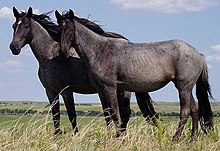Nokota horse

Two young mares
|
|
| Country of origin | United States |
|---|---|
| Traits | |
| Distinguishing features | Angular frame, often blue roan, often exhibits an ambling gait |
| Breed standards | |
The Nokota horse is a feral and semi-feral horse breed located in the badlands of southwestern North Dakota in the United States. The breed developed in the 19th century from consisting of ranch-bred horses produced from the horses of local Native Americans mixed with Spanish horses, Thoroughbreds, harness horses and related breeds. The Nokota was almost wiped out during the early 20th century when ranchers, in cooperation with state and federal agencies, worked together to reduce competition for livestock grazing. However, when Theodore Roosevelt National Park was created in the 1940s, a few bands were inadvertently trapped inside, and thus were preserved.
In 1986, the park sold off a large number of horses, including herd stallions, and released several stallions with outside bloodlines into the herds. At this point, brothers Leo and Frank Kuntz began purchasing the horses with the aim of preserving the breed, and founded the Nokota Horse Conservancy in 1999, later beginning a breed registry through the same organization. Later, a second, short-lived, registry was begun by another organization in Minnesota. In 2009, the North Dakota Badlands Horse Registry was created, which registers the slightly different type of horses which have been removed from the park in recent years. Today, the park conducts regular thinning of the herd to keep numbers between 70 and 110, and the excess horses are sold off.
The Nokota horse has an angular frame, is commonly blue roan in color, and often exhibits an ambling gait called the "Indian shuffle". The breed is generally separated into two sections, the traditional and the ranch type, which differ slightly in conformation and height. They are used in many events, including endurance riding, western riding and English disciplines.
...
Wikipedia
